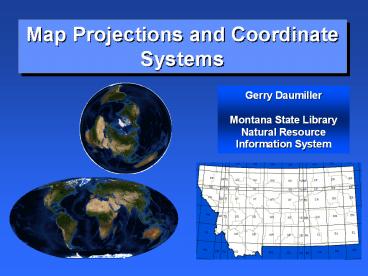Map Projections and Coordinate Systems - PowerPoint PPT Presentation
Title:
Map Projections and Coordinate Systems
Description:
Developed by National Imagery and Mapping Agency (NIMA, formerly Defense Mapping ... National Geographic's 'Round Earth, Flat Map' ... – PowerPoint PPT presentation
Number of Views:1747
Avg rating:3.0/5.0
Title: Map Projections and Coordinate Systems
1
Map Projections and Coordinate Systems
Gerry Daumiller Montana State Library Natural
Resource Information System
2
Map Projections
Why are they important?
An important thing to remember about map
projections is that you can not generally measure
distances and areas accurately from projected
data. The next slides show some examples of this.
3
(No Transcript)
4
(No Transcript)
5
Length Distortion on World Maps
Robinson Projection -- 16,930 Miles
Length of the Arctic Coastline of Russia
6
Area Distortion on World Maps
7
Linear Distortion on National Maps
Albers Equal Area Projection -- 2564.3 Miles
Oblique Mercator Projection -- 2583.9 Miles
Difference 19.6 Miles One part in 132 0.76
Percent
8
Area Distortion on National Maps
Lambert Conformal Projection -- 147,657 Square
Miles
Albers Equal Area Projection -- 148,993 Square
Miles
Difference 1336 Square Miles One part in
111 0.90 Percent
9
Linear Distortion on Local Maps
Montana State Plane Coordinates 39,189.6 feet
Oblique Mercator Projection 38,212.1 feet
Difference 27.5 feet One part in 1742
0.0574 Percent
10
Area Distortion on Local Maps
Montana State Plane Coordinates -- 122,314.3 Acres
Albers Equal Area Projection -- 122,425.2 Acres
Difference 110.9 Acres One part in 1104
0.091 Percent
11
Coordinate Systems vs.Map Projections
- A map projection is a method or a type of
equation used to transform three-dimensional
coordinates on the earth to two-dimensional
coordinates on the map. - A coordinate system usually includes the
specification of a map projection, plus the three
dimensional model of the Earth to be used, the
distance units to be used on the map, and
information about the relative positions of the
two dimensional map and the model of the Earth.
12
(No Transcript)
13
Latitude-Longitude
14
Latitude-Longitude
- Not uniform units of measure
- Meridians converge at the Poles
1 longitude at Equator 111 km at 60 lat.
55.8 km at 90 lat. 0 km
1 latitude at Equator 111 km at 90
lat. 112 km
15
Using Geographic Coordinates as Plane Coordinates
Projected Coordinates
Geographic Coordinates
16
Spheroids
- Set of parameters that represent a model of the
earths size and shape - Based on an ellipse with 2 radii
- Semimajor axis (longer) and the semiminor
(shorter)
17
Spheroids
- The Earth is not a perfect spheroid. Different
spheroids are used in different parts of the
world to create the best possible model of the
Earths curvature in each location.
18
Spheroids
19
Datums
- A Datum is a spheroid, plus the definition of the
relationship between the Earth and the
coordinates on the spheroid.
20
Datums
- There are four datums commonly used in Montana
NAD27, WGS84, NAD83, and NAD83 HARN. The
latitude and longitude of a point on the ground
is different in each datum.
21
Datums
- Difference (meters) between NAD27 and NAD83
22
Datums
- Difference (meters) between NAD83 and NAD83 HARN
23
Projected Coordinate Systems
- Define locations on a 2-D surface
- Traditional planar coordinates
- Can allow easy measurement, calculation, and/or
visual interpretation of distances and areas
24
Visualize a light shining through the Earth onto
a surface
ESRI
25
Mercator Projection
26
Miller Projection
27
Cylindrical Equal-Area Projection
Mollweide Projection (equal-area,
psuedo-cylindrical)
28
Perspective Projection
29
Stereographic Projection
30
Conic Projections
31
Conic Projections
Lambert Conformal
Albers Equal Area
32
Standardized Coordinate Systems
There are an infinite number of coordinate
systems possible, which can be created by
choosing a projection and then tailoring
its parameters to fit any region on the
globe. Standardized coordinate systems have been
developed to simplify the process of choosing a
system. The two most common standard systems
used in the United States are the State
Plane Coordinate system and the Universal
Transverse Mercator system.
33
SPCS NAD27 NAD83 Zones for the Northwest
ESRI
34
UTM
35
Choosing a Projection Checking Accuracy
To find the true area of polygons, project them
to an equal-area projection and recalculate their
areas.
To find the true distance between two points
http//www.ngs.noaa.gov/cgi-bin/Inv_Fwd/inverse.p
rl
36
Accuracy of Projections State Plane Single Zone
37
Accuracy of Projections State Plane North Zone
38
Accuracy of Projections State Plane Central Zone
39
Accuracy of Projections UTM Zone 12
40
Accuracy of Projections Albers Equal Area
41
Accuracy of Projections Albers Equal Area
42
Accuracy of Projections -- Statistics
Maximum error in Montana for each coordinate
system LENGTH AREA Percent
Ratio Percent Ratio UTM Zone 12 0.334
299 0.554 180 State Plane 1983 0.075
1333 0.114 877 State Plane North 0.269
372 0.420 238 (within zone) 0.008 12500 0.01
3 7962 State Plane Central 0.142 704 0.198
505 (within zone) 0.008 12500 0.039
2564 State Plane South 0.167 599 0.236
424 (within zone) 0.013 7692 0.021 4761
43
Projections and True North
http//nris.mt.gov/gis/gerry/true_north.txt

